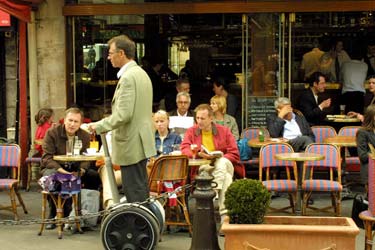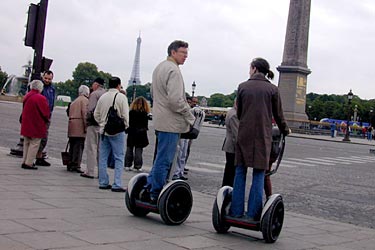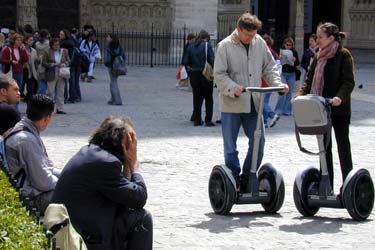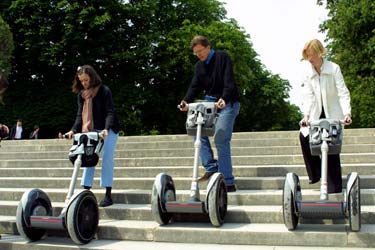Liberté, Egalité, Fraternité—and Segway
<a href=slate.msn.com>slate.msn.com, Friday, May 23, 2003, at 9:12 AM PT
Not everyone at Notre-Dame embraces the concept of the Segway.Paris is a walker's city, built for sauntering, window-shopping, the sideways topple into the cafe chair. On our final day here, we finally realized that the best way to get around on Segways is to use the bike lane rather than the sidewalk. The ride is fast and uncluttered, and you aren't constantly giving pedestrians heart attacks. Technically, Segwaying in the street is illegal, but the policemen who stared us down at intersections and in front of President Chirac's house all seemed to be following the same penal-code decision tree ("Not a bicycle, yet has two wheels and moves in a leisurely manner: ALLOW TO PROCEED").
 Our belated epiphany came courtesy of David Mebane, the owner of Mike's Bike Tours, which conducts bicycle tours of the city. (Yes, he knows it should be called David's Bike Tours; long story.) David, an easygoing 27-year-old Texan, led us around Paris for four hours on his Schwinn as we followed on our Segways, "Make Way for Ducklings"-style. Every once in a while he would stop, lean over the handlebars, and explain something: "Marie Antoinette's head was lopped off in the place there, totally decapitated by the guillotine"; "If you go over to the third window to the right of that arch of the Louvre, you can look in and see the Venus de Milo for free"; "Down there in the Hôtel des Invalides, my favorite building in Paris, so beautiful when it's all lit up at night, the French resistance built a false ceiling in the dome—just below that second level of windows. They hid U.S. airmen who'd been shot down, bomber crews and so on, between the two ceilings."
Our belated epiphany came courtesy of David Mebane, the owner of Mike's Bike Tours, which conducts bicycle tours of the city. (Yes, he knows it should be called David's Bike Tours; long story.) David, an easygoing 27-year-old Texan, led us around Paris for four hours on his Schwinn as we followed on our Segways, "Make Way for Ducklings"-style. Every once in a while he would stop, lean over the handlebars, and explain something: "Marie Antoinette's head was lopped off in the place there, totally decapitated by the guillotine"; "If you go over to the third window to the right of that arch of the Louvre, you can look in and see the Venus de Milo for free"; "Down there in the Hôtel des Invalides, my favorite building in Paris, so beautiful when it's all lit up at night, the French resistance built a false ceiling in the dome—just below that second level of windows. They hid U.S. airmen who'd been shot down, bomber crews and so on, between the two ceilings."
 He had the patient manner of someone who must explain to American visitors, several times a day, why the ATMs here don't dispense dollars. While an implacable enemy of French bureaucracy, he loves the French and their history. At Place Clemenceau, he wheeled up beside a dark green statue of Charles de Gaulle and said, "Little World War II story. Obviously, de Gaulle was leading the Gaullist resistance, but there was also a Communist resistance, and when the Allies took Paris back there was a void of power—who's going to take over? August, 1944, de Gaulle flies in from London to take command but gets extremely low on fuel, it's a near thing, is he going to make it?" I guessed that he would. "He lands with nothing in the tank," David continued, "then walks down the Champs Elysées in a big parade with all the soldiers and citizens, from the Arc de Triomphe to Notre-Dame, with German snipers on rooftops taking potshots at him, whatever, craziness, but nobody hits him and he takes the keys to the city. There's just this tremendous celebration of liberation."
He had the patient manner of someone who must explain to American visitors, several times a day, why the ATMs here don't dispense dollars. While an implacable enemy of French bureaucracy, he loves the French and their history. At Place Clemenceau, he wheeled up beside a dark green statue of Charles de Gaulle and said, "Little World War II story. Obviously, de Gaulle was leading the Gaullist resistance, but there was also a Communist resistance, and when the Allies took Paris back there was a void of power—who's going to take over? August, 1944, de Gaulle flies in from London to take command but gets extremely low on fuel, it's a near thing, is he going to make it?" I guessed that he would. "He lands with nothing in the tank," David continued, "then walks down the Champs Elysées in a big parade with all the soldiers and citizens, from the Arc de Triomphe to Notre-Dame, with German snipers on rooftops taking potshots at him, whatever, craziness, but nobody hits him and he takes the keys to the city. There's just this tremendous celebration of liberation."
 Amanda looked up at de Gaulle in his uniform and kepi. "He looks like he belongs in Singin' in the Rain," she said. The figure did look rather as if it were beginning to pirouette and break into song.
Amanda looked up at de Gaulle in his uniform and kepi. "He looks like he belongs in Singin' in the Rain," she said. The figure did look rather as if it were beginning to pirouette and break into song.
 "Or like the Morton Salt girl," David said.
"Or like the Morton Salt girl," David said.
 It was a sunny day at last, and all Paris seemed to be out and in a cheerful mood. It might well have just been coincidence, but cultural understanding of the Segway seemed to have seeped into the collective consciousness. On our first day here no one knew what the machine was, but today four different people seemed to know all about the Segway and its gyroscopes and began explaining it to other bystanders as we talked nearby.
It was a sunny day at last, and all Paris seemed to be out and in a cheerful mood. It might well have just been coincidence, but cultural understanding of the Segway seemed to have seeped into the collective consciousness. On our first day here no one knew what the machine was, but today four different people seemed to know all about the Segway and its gyroscopes and began explaining it to other bystanders as we talked nearby.
 As we slalomed around I.M. Pei's glass pyramid in the Louvre's courtyard, a photographer who shoots Polaroid photos of tourists there at 6 euros a snap began asking rapid-fire questions. A short, intense man in a red windbreaker, he was curious about the Segway's range. When I said that it was 17 to 25 kilometers, he frowned and seemed to take against the whole idea. "But that's nothing," he said. "Paris is very large—what can you do with 20 kilometers? You can't get to the office and back!"
As we slalomed around I.M. Pei's glass pyramid in the Louvre's courtyard, a photographer who shoots Polaroid photos of tourists there at 6 euros a snap began asking rapid-fire questions. A short, intense man in a red windbreaker, he was curious about the Segway's range. When I said that it was 17 to 25 kilometers, he frowned and seemed to take against the whole idea. "But that's nothing," he said. "Paris is very large—what can you do with 20 kilometers? You can't get to the office and back!"
David took up the cudgels. After riding the Segway in the courtyard, he had decided that he wanted one for leading his tours. "You can always recharge. It takes no time." (Well, five or six hours.)
"Four hours of use before you need to recharge, it's nothing," the photographer said. "My cell phone has a five-hour charge! And whose boss will let them charge the machine at the office?"
"The Segway engineers are working on extending the battery life," David said, which is true, but he was winging it. "The newest technology, magnesium—" he looked at me.
"Cadmium," I said, not entirely sure if that was what you use for batteries or enemas.
"Cadmium," David repeated confidently. "All the problems will be solved. Now, if this machine were a little cheaper and had a larger range, would you be interested?"
The photographer lowered his sunglasses and looked at it again, up and down, then broke into a charming smile. "It is very interesting," he said. "Very."
After we wound through the crooked streets of the Marais and had some superb sandwiches at Lina's, just off the rue de Rivoli, I noticed that my battery indicator was getting low. Halfway up the Champs Elysées, it indicated that I had no reserve at all, and as we were entering the home stretch on rue de Bassano, the user interface screen begin flashing red: nothing in the tank! My Segway was slowing, creeping, humming just a little: Would I make it?
I guessed that I would. And indeed I coasted up to the front door of the hotel with nothing in the tank. There was no tremendous celebration of liberation, just a chance to get off and recharge and think happy thoughts about the imminent possibility of dinner. The French helped liberate us in 1776, we returned the favor later, and now both countries are free to be provoked and intrigued by each other and to disparage each other's wine.
Amanda had been following right behind me to give me a push if necessary. "Liberté, Egalité, Fraternité—and Segway," she said.